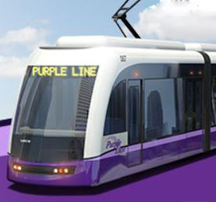Years of Resistance to Transit Alternatives for I-270
The State Highway Administration has been studying plans to widen I-270 north of Shady Grove for many years. By 1997, work was well underway. But the Action Committee for Transit and the Sierra Club objected to the SHA's plans, arguing that a transit alternative was needed in the study.
In 1997, the Transportation Planning Board of the Metropolitan Washington Council of Governments rejected SHA's plans for an I-270 study and told the state agency that it had to include a transit alternative. ACT's September 1998 newsletter gives the details. SHA responded by promising to add an Alternative 5 consisting of the Corridor Cities Transitway plus HOV-only lanes on I-270. ACT objected to this, since HOV lanes are roads and not transit. But the Alternative 5 that was actually studied wasn't even a real HOV alternative. It added numerous general-purpose lanes in addition to the HOV lanes. Between Shady Grove and Watkins Mill Road, the highway would be 14 lanes wide. In the area just north of Shady Grove, there were six new lanes of regular traffic. One existing northbound lane - a lane that SHA had opened to all cars after promising HOV when the project was approved - would be converted to HOV.
Montgomery County's Transportation Policy Report of 2001 tested a scenario much like today's I-270 transit vision. Traffic modeling showed transit ridership was huge, with the Metro extension alone showing more ridership than the current eastern Red Line outside Silver Spring. The expanded MARC service also showed very high ridership. Yet SHA persisted in its highway-first approach. Under the Ehrlich administration, the study added two new scenarios with toll lanes, but still no all-transit scenario.
Today the Obama Administration is seeking to transform national transportation policy, resulting in a level playing field for transit project reviews, and substantially more money for commuter rail and transit. Studying and planning for a comprehensive transit system alternative would position Maryland to win funding for this expanded transit system.

